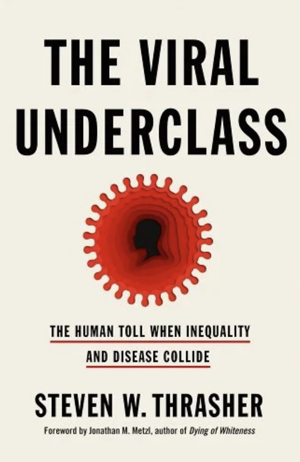
This summer, yet another disease unfamiliar to most people in the United States is being transmitted around the world—as is the impulse to find someone to blame. Many news stories about the current monkeypox outbreak make reference to a “patient zero,” supposedly the one person who brought the virus into a particular state or community. This kind of finger-pointing, which long predates monkeypox, is a deeply flawed framing. Worse yet, stigmatizing individuals who get sick—and portraying the social, interconnected nature of communicable disease as an individual matter—actually impedes efforts to slow the spread of infection.
[Read: So have you heard of monkeypox?]
We’ve been here before. When the term patient zero first began to circulate, during the early days of the AIDS epidemic, in the 1980s, it etymologically invoked ground zero, a term coined near the end of World War II to describe the point closest to a nuclear explosion. In the summer of 1945, this referred to the sandy ground in New Mexico—where the first atomic bomb was tested—and to Japanese soil beneath Hiroshima and Nagasaki, where the United States dropped nuclear bombs that killed about a quarter million people. Decades later, after hijackers flew two 767s into the World Trade Center’s Twin Towers, the heaping pile of burning wreckage left behind was dubbed Ground Zero.

When patient zero was first used in relation to a person living with AIDS, it was as if that person contained the kinetic energy and evil of an atomic weapon. And when it was invoked decades later to describe the first person thought to be living with SARS-CoV-2 in various communities, the term associated any person living with the novel coronavirus with all the malevolent intent of hijackers who had purposefully killed thousands of people. Of course, people living with viruses or bacteria are not bombs or terrorists.
The first popular use of patient zero was largely predicated on a mistake. In the 1987 book And the Band Played On: Politics, People, and the AIDS Epidemic, the journalist Randy Shilts identified and vilified Gaetan Dugas, a French Canadian flight attendant who died of AIDS in Quebec City in 1984, as the “patient zero” who had spread AIDS around North America. But in 2016, a study in the journal Nature yielded evidence that HIV had been circulating in North America since at least 1970.
According to Shilts’s book and Dugas’s friends, the flight attendant was a sexually active gay man. By his own count, he had sex with hundreds of partners. But in the years after the Stonewall riots of 1969, when many gay men felt free for the first time to express their sexuality, having so many sexual partners was not considered unusual or even necessarily unhealthy.
This all changed when doctors, nurses, and journalists began noticing in the early 1980s that gay men were dying of an unusual cancer. No one (gay, bi, or straight) initially knew that a relatively inefficient virus—HIV needs a high number of humans to repeatedly swap blood, milk, or semen with many other people—had begun circulating among them. In one of the great peer-to-peer public-health campaigns of modern medicine, many gay men did eventually come to use condoms consistently during sex. But it took time. As any person who has struggled not to shake hands, hug their friends, kiss their kin, get closer than six feet to people they love, spend time indoors with others, or touch their face during the coronavirus pandemic can tell you, adjusting behaviors takes time.
In his book, Shilts frames the HIV crisis as a detective story in which the key to understanding the epidemic requires crusaders to hunt down “patient zero.” While Shilts writes, “Whether Gaetan Dugas actually was the person who brought AIDS to North America remains a question of debate and is ultimately unanswerable,” he asserts just a few lines later that “there’s no doubt” that “Gaetan played a key role in spreading the new virus from one end of the United States to the other.”
And the Band Played On, like a lot of journalism, suffers from an inherent bug: It reported the story before the ending was known. Shilts, who died in 1994, didn’t live to see the major advances in antiretroviral medication. He never got to reexamine, with the benefit of time passed, the story he helped set in motion. But he did bear responsibility for framing and marketing the book as he did. Long before the Nature article showed at a microscopic level that Dugas could not have been the first person with HIV in North America, Shilts’s overwrought emphasis on Dugas’s sex life had been widely criticized by historians, social scientists, and public-health researchers.
[Read: How one man was wrongly blamed for bringing AIDS to America]
Dugas was never supposed to have been known as Patient Zero at all. Rather, he was supposed to be Patient O—as in the letter. When contacted by investigators tracking the movement of the new virus, Dugas was cooperative, giving them the names of 750 men he’d had sex with. One investigator, who was primarily researching men who lived in California, labeled Dugas “Patient O” for being “outside” California.
Many people mistakenly read that capital letter O as a zero. In his 2017 book, Patient Zero and the Making of the AIDS Epidemic, Richard A. McKay (who co-authored the Nature study) wrote, “For years, several successive editions of a top-selling medical dictionary—a type of publication frequently considered to bear the ultimate imprimatur of authority—contained an entry for Patient Zero which read: ‘an individual identified by the Centers for Disease Control and Prevention (CDC) as the person who introduced the human immunodeficiency virus in the United States. According to CDC records, Patient Zero, an airline steward, infected nearly 50 other persons before he died of acquired immunodeficiency syndrome in 1984.’”
As a gay journalist, Shilts gave an enormous boost to this framing. He also granted cover to many straight journalists and scientists to treat the crisis not as an ethical failure of society to support a marginalized population devastated by an epidemic, but as the fault of one horny gay man. According to The New York Times, “in a 1993 interview, Mr. Shilts said he had heard C.D.C. investigators use the term Patient Zero and thought, ‘Oooh, that’s catchy.’” The Times also said that Shilts had “said he was initially horrified that his publisher, St. Martin’s Press, focused his book tour on Patient Zero instead of the government’s slow response to the epidemic, but he went along.”
Shilts’s choices were not unusual; they were common throughout media and society. Scapegoating one person, Dugas, made it all the easier for the government to say that AIDS was a failure of gay people to behave responsibly. It deflected blame that should have been directed at the federal government for the economic and homophobic conditions that allowed HIV to reproduce so quickly. It made it harder for groups like the AIDS Coalition to Unleash Power (ACT UP) to force the government to treat AIDS patients with dignity. And it primed a response to COVID-19 in which Americans spent more time blaming infrequent “COVID parties” or people going to the beach than examining the economic forces fueling the pandemic.
Around the time And the Band Played On came out, in 1987, the Chicago Tribune ran a screaming all-caps headline: “CASE SHAKES THEORIES OF AIDS ORIGINS.” The article brought into question not just Shilts’s misguided obsession with Patient Zero but the entire American understanding of HIV’s timeline.
[Read: The LGBTQ health clinic that faced a dark truth about the AIDS crisis]
In late 1968, a Black teenager named Robert Rayford was hospitalized in St. Louis with pneumonia. He had been in and out of the hospital for months with mysterious ailments. When he “finally entered the hospital” for the last time, the Tribune reported, Rayford’s “lower legs and genitals had been swollen,” and “the black teenager had grown thin and pale, fatigued and short of breath, and now his bloodstream swarmed with the microbe called Chlamydia.”
Rayford told doctors that he had been having symptoms since 1966. Short of breath, he had an immune system that was incomprehensibly failing. When he died on May 15, 1969, at age 16, the official cause was listed as pneumonia. But during an autopsy, doctors found Kaposi sarcoma tumors, which had been known to affect primarily older men living near the Mediterranean Sea.
Rayford’s death was so unusual that tissue samples were saved from his corpse. In the mid-1980s, as HIV/AIDS was first beginning to be understood, researchers thawed and tested tissue from Rayford’s body and found HIV antibodies. In his brief life, Rayford not only developed cancer, genital edema, proctitis, and bruising in his rectum but also lived with viruses such as herpes, cytomegalovirus, Epstein-Barr, and, the posthumous test strongly suggests, HIV.
Journalistic and scientific writing about people living with viruses often has a dehumanizing quality. A 2020 New York Times article on coronavirus “superspreaders” crudely stated that “some people become virus chimneys, blasting out clouds of pathogens with each breath.” The term superspreader evokes superpredators, the racist term then–first lady Hillary Clinton infamously evoked in 1996, characterizing youth as not “just gangs of kids anymore” but “the kinds of kids that are called superpredators—no conscience, no empathy” and who needed to be brought “to heel.” Similarly, Rayford was described after his death as possibly a “male prostitute” by one of his doctors and as “a bag of producing chlamydia” by another.
Today, Rayford is considered an important individual “associated with the disability history of the United States”—the hospital where he stayed is included on the National Register of Historic Places run by the National Park Service. “How did Rayford contract the virus more than a decade before HIV/AIDS was identified and reached epidemic proportions in the 1980s?” the National Park Service asks on its website, adding, “How many people had suffered and died from the mysterious illness before it was identified?” According to the AIDS scholar and activist Theodore Kerr, who has done extensive research on Rayford, the child wasn’t the right fit for a patient-zero archetype. “We can be so cruel,” Kerr told me, saying that storytellers of early AIDS history “could just, like, eat Dugas alive in a way that we wouldn’t have done to Robert Rayford.” As a child, Rayford fortunately couldn’t be pathologized like the adult flight attendant. But as a Black child, Kerr said, Rayford was subjected to cruelty of a different kind: “We just ignored him instead.”
The first people affected by viruses can be so deep in the underclass that most of society neglects them. Think of the people who injected drugs who likely died of AIDS in the 1970s. There was little collective concern over the people who had “junkie pneumonia,” “the dropsies,” or “the dwindles.” Similarly, people who collect bat or bird feces for fertilizer from caves may have caught and died from SARS-CoV-2 months before it was first reported in Wuhan, but they were socially isolated, and no one likely ever knew why they’d died. And consider that countries in western central Africa have dealt with monkeypox outbreaks for decades—but that the virus is getting global attention only now that it has spread to countries in Europe and North America.
Still, the National Park Service calling Rayford “the first HIV/AIDS patient in the United States” carries a real danger of inscribing upon him the patient-zero myth. It would be wrong for anyone to carry the stigma and weight of a social disease by himself.
We all share the responsibility of life on a planet with viruses. But those of us living without the most lethal types of them must shoulder the responsibility more. The media heap a tremendous weight on people living with disease, whether it be COVID, AIDS, or monkeypox, making them feel like they’re a burden or some kind of individual failure—and the toll of this can be deadly.
This article is adapted from Steven Thrasher’s new book, The Viral Underclass: The Human Toll When Inequality and Disease Collide.







